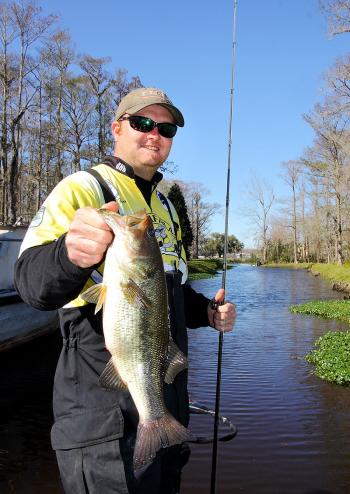
Tournament angler Luke Fears of Bayou Vista fishes a grass
mat near Stephensville in this undated photo. (Submitted Photo/Courtesy of John K. Flores)
Anglers punch grass to put winning weight on the scale
By JOHN K. FLORES
You don’t have to be a weatherman to know we are in that typical late winter weather pattern where we go from one temperature extreme to another. Late last week on the morning of Jan. 30, it was 21 degrees locally and west of our area all the way to Lake Charles in the coastal region, it was as low as 19 degrees. By late afternoon Saturday, the temperature approached the mid-70s.
Simply put, the temperatures have been up and down like a yo-yo. What’s more, it looks like it will remain that way for the next couple of weeks.
Yet in spite of these unpredictable weather patterns, one thing that is predictable for this time of year is the number of bass tournaments anglers will be participating in. And who puts the most weight on the scale during winter conditions often comes down to a single tactic.
The trouble is, during February and March, the water temperature has a wide range. Moreover, all of these tournament anglers know the spawn can kick off at any moment when the water temperature is in the 55- to 65-degree range.
Local tournament angler Randy Radar found himself fishing in tough cold water conditions a couple weeks back looking for a bite. He posted a picture on his Facebook page of himself approaching a mat of grass, with the caption, “Gotta be at least one cold fish in that patch.”
The cold water tactic Radar has learned and mastered during the years is what bass anglers refer to as “punching grass.” And it can be deadly.
“In the morning the water temperature was 39 degrees,” Radar recounted. “The warmest water I found was 41.6 and I did get bit in three feet of water. But, I typically look for mats that are in at least 18 inches to four feet of water.”
What makes this tactic so effective is basically a bass’ survival instinct. The sun’s radiation, which is prevalent even on cloudy days, combined with the grass mat’s ability to absorb and hold heat like a sponge, provides a warm haven for these predator fish.
Radar said, “Depending on the type of area, whether it’s marsh, banks, canals, etc., during the winter months the mat heats up quicker and the vegetation retains the heat transferring it to the underlying area. This may be a three- to five-degree difference, but it’s enough to hold fish. Also, with the sun high, it’s a place for them to seek shelter.”
According to Radar, he uses a “punch and go” type presentation and doesn’t spend much time at each mat. By contrast, other bass anglers, he mentions, will fish them slower and longer. Additionally, the angler says he fishes the thickest area of the mat first, stating that’s where typically the bigger bass are holding. If he doesn’t get a strike he then works his way around the mat.
Punching grass requires heavy line for hauling big bass through the mats. And, heavy line for most bass anglers means braided line. Radar uses 65-pound test braided line. Others will use 50- and 60-pound test. Though I haven’t heard of a minimum test braid, 30-pound test should be the lowest anglers consider going.
Punching grass requires something heavy enough to get through a mat. Ivy St. Romain, owner of Ivy’s Tackle Box in Morgan City, says he prefers a tungsten weight because the end of the weight has a deeper concave than lead. St. Romain has fished his share of B.A.S.S. Tournaments and has punched his share of grass during the years.
St. Romain uses a 5/0 flipping hook and ¾-ounce weight when he punches grass. His basic rig is pretty simple to construct.
Romain said, “I’ll slide a bobber stop up the line and then add a Delta Lure punch skirt before adding the tungsten weight. Punch skirts I find cover and hide the weight better. I’ll tie the flipping hook using a clinch knot, and the bait I use is a Kandi Texas Kraw in watermelon red color. Depending on how thick the grass is depends on how heavy a weight I’ll use. But, I’ll use ¾-ounce to 1 ounce tungsten when punching grass.”
Radar says he’ll punch the mat and jiggle it on the bottom a few times. If he doesn’t get a bite, he’ll pick it up and punch the grass again in close proximity. Other anglers will yo-yo their bait a few times and let it set on the bottom several seconds afterwards.
One thing for sure, the weather pattern for about the next week shows daytime highs ranging 46 to 65 degrees and overnight lows 28 to 49 degrees. This isn’t going to discourage bass anglers from scouting a few locations or participating in tournaments this weekend. Punching a few grass mats just may be the way to put some winning weight on the scale.
If you wish to make a comment or have an anecdote, recipe or story to share, you can contact John K. Flores at 985-395-5586 or gowiththeflo@cox.net or visit www.gowiththeflooutdoors.com
- Log in to post comments
